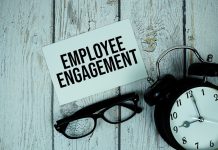The current workplace is a melting pot. If you look around your office, you’ll likely see that your colleagues span four generations of workers with a nearly 60-year age difference. Such a rich mix of generations can be attributed to the increased graduation rate among tech-savvy Millennials and the rising average age of retirement. However, with the growing number of young minds and seasoned executives also come varying ideas, values, and experiences—and a bit of a conundrum for training and HR professionals who are trying to get everyone on the same page.
As a result, most companies (of all sizes, but especially those on the larger side) are in the unique position of needing to reevaluate their approach to certain processes, especially those related to collaboration and training. No blanket-style approach here—each generation’s characteristics affect how they work, communicate, and learn, ultimately influencing engagement and productivity. Before determining how best to manage and train a multi-generational workforce, though, it’s important to understand the polarization—especially as it relates to learning—and footprint in the workforce.
Traditionalist Generation
The Traditionalist/Veteran Generation is made up of workers born between 1925 and 1945. They are loyal, disciplined, and knowledgeable, a result of their World War II upbringing. The political and economic uncertainty of their time has led them to be risk adverse but with a respect for authority and a command and control style of leadership. Traditionalists currently make up 4 percent of the workforce, and are less likely to expect continuous engagement in the office—they rely on their experience as direct sources of learning and as such, aren’t as willing to make the shift to new forms of communication.
Baby Boomer Generation
Workers of the Baby Boomer generation were born between 1946 and 1964. While most are approaching or have passed the typical retirement age of 65, nearly half reported in a recent study that they don’t expect to retire until they are 66 or older. It is Boomers’ known competitive, go-getting work ethic that has kept the generation at about one-third of the workforce. Despite owning a strong piece of the workforce pie, Boomers are similar to Traditionalists in that they haven’t made the technological shift. They also tend to disengage if they feel their contributions aren’t being appropriately rewarded.
Generation X
Generation X workers are those born between 1965 and 1980, and they are typically independent and adaptable. They like to be engaged and involved, and are increasingly comfortable learning through multimedia. They make up nearly the same percentage of the workforce as their Baby Boomer counterparts, representing 32 percent of the workforce, but overall are a relatively small generation at 41 million. While Gen X is rallying for a more fluid use of their time in the workplace, they are dangerously disengaged unless trusted to do things their way.
Generation Y
The Millennial workforce is the most educated and technologically literate generation, having been born between 1981 and 2000. They are also the most diverse of the generations, as well as the most adept at multitasking and working as part of a team. In 2013, it was projected that by 2014, Millennials would comprise 36 percent of the workforce, and by 2020, they will be nearly half of all workers. Gen Y workers relish technology and real-time interaction, and whereas other generations may see constant communication as a waste, Millennials prefer to learn by doing and discovering alongside others.
Bringing the Workforce Together
As seen through their descriptions, at the crux of the multi-generational conundrum for trainers is technology, one of the biggest barriers to seamless communication and exceptional productivity. While it’s important to pay mind to how people prefer to receive information, it’s also important to note that despite varying generational values, the way in which all employees work is changing. In this fast-paced day and age, it’s less about quality content and more about informative content. So how do you ensure the content is useful? Cue in an organization-wide learning solution that allows trainers to create videos for all types of learners, and then securely share them in the company space.
Video is a must-do as it allows trainers to deliver a single piece of content in a format that is accessible and digestible. It can be optimized per learner, by supplementing imagery with text, audio narration, and the like, which is likely to be appealing regardless of generation. But remember, it’s not necessarily about it being pretty, as much as it is about it being informative. When generations feel confident in their ability to absorb content, they’re more likely to transfer it as well. Older workers can offer their vast industry knowledge and experience, and younger workers can shed light on emerging trends. A screencast video for example can be created by a manger to capture institutional knowledge about processes or company best practices, while a series of videos can be created by a junior-level employee to chronicle daily deliverables and internal team relations.
Overall, the great thing about visual communication is that for all of the generations, it has been used repeatedly throughout their lifetime. Traditionalists have seen everything from the advent of television to color photographs in Life Magazine, and Baby Boomers have gone from watching events around the world to those outside of this world. Generation X had MTV, and Millennials have everything on the Internet. Each generation has become accustomed to seeing more, and seeing more visually. But these are just the latest waves; the use of visuals goes back to the earliest of times, all the way to the use of Sanskrit rock art to tell stories.
Rest assured, trainers—visuals are a good investment. The right visual can convey key information, which doesn’t need to get caught in the trappings of any one technology or learning style. Each generation brings its own set of skills to the office, and it is visual communication that permeates nuances and allows workers to learn—and learn effectively.
Matt Pierce is integrated marketing manager for video and social media at TechSmith Corp., a software company that provides practical business and academic solutions that change how people communicate and collaborate across devices. A graduate of Indiana University’s School of Education’s Department of Instructional Systems Technology, Pierce has 10 years of experience working in learning and development with a focus on visual instruction. He has directly managed the training and user assistance teams for TechSmith, and also has run its visual communication Web show, The Forge, interviewing guests from around the world about the use of visuals, video, and technology in education, training, marketing, and more. Teach him something @piercemr.




